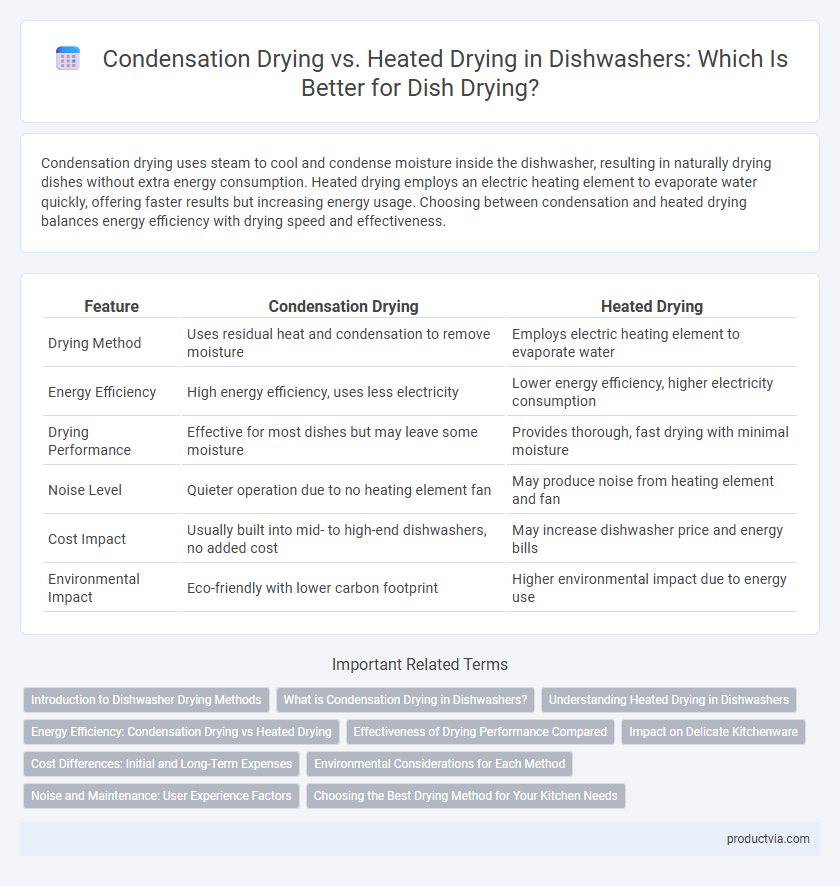Condensation drying uses steam to cool and condense moisture inside the dishwasher, resulting in naturally drying dishes without extra energy consumption. Heated drying employs an electric heating element to evaporate water quickly, offering faster results but increasing energy usage. Choosing between condensation and heated drying balances energy efficiency with drying speed and effectiveness.
Table of Comparison
| Feature | Condensation Drying | Heated Drying |
|---|---|---|
| Drying Method | Uses residual heat and condensation to remove moisture | Employs electric heating element to evaporate water |
| Energy Efficiency | High energy efficiency, uses less electricity | Lower energy efficiency, higher electricity consumption |
| Drying Performance | Effective for most dishes but may leave some moisture | Provides thorough, fast drying with minimal moisture |
| Noise Level | Quieter operation due to no heating element fan | May produce noise from heating element and fan |
| Cost Impact | Usually built into mid- to high-end dishwashers, no added cost | May increase dishwasher price and energy bills |
| Environmental Impact | Eco-friendly with lower carbon footprint | Higher environmental impact due to energy use |
Introduction to Dishwasher Drying Methods
Dishwasher drying methods primarily include condensation drying and heated drying, each impacting energy efficiency and drying performance. Condensation drying uses residual heat and cools the dishwasher interior to condense moisture on cooler surfaces, reducing energy consumption. Heated drying employs electric heating elements to speed up evaporation, delivering faster and more thorough drying but increasing energy use.
What is Condensation Drying in Dishwashers?
Condensation drying in dishwashers involves using residual heat and cooler interior walls to evaporate and condense moisture on the appliance's surface, allowing dishes to air dry without additional energy consumption. This energy-efficient method reduces the need for heating elements, lowering electricity usage compared to heated drying cycles. Condensation drying is especially effective on plastic items that retain water drops, offering a quieter and environmentally-friendly alternative in modern dishwasher models.
Understanding Heated Drying in Dishwashers
Heated drying in dishwashers uses an electric heating element to raise the temperature inside the tub, effectively evaporating water from dishes for faster and more thorough drying. This method typically results in fewer water spots and a drier finish compared to condensation drying, which relies on residual heat and natural cooling to remove moisture. Understanding the energy consumption and potential impact on delicate items is important when choosing between heated drying and condensation drying cycles in modern dishwashers.
Energy Efficiency: Condensation Drying vs Heated Drying
Condensation drying uses natural heat from the dishwasher's final rinse to evaporate moisture, making it significantly more energy-efficient than heated drying, which relies on electric heating elements to blow warm air. This method reduces electricity consumption by up to 40% compared to traditional heated drying cycles. Modern dishwashers with condensation drying not only save energy but also lower operating costs and carbon emissions.
Effectiveness of Drying Performance Compared
Condensation drying in dishwashers relies on natural evaporation and cool surfaces to remove moisture, resulting in energy-efficient but often less thorough drying, especially for plastics. Heated drying uses electric heating elements to actively evaporate water, providing faster and more consistent drying performance across all types of dishes. Studies indicate heated drying achieves higher dryness levels with shorter cycle times, though it consumes more energy compared to condensation drying.
Impact on Delicate Kitchenware
Condensation drying is gentle on delicate kitchenware, minimizing the risk of warping or damage by using residual heat and natural moisture absorption. Heated drying employs higher temperatures that can warp plastic items and weaken fine glasses over time due to prolonged exposure to heat. Choosing condensation drying extends the lifespan of fragile dishes by ensuring a safer, low-heat drying environment.
Cost Differences: Initial and Long-Term Expenses
Condensation drying systems generally have lower initial costs compared to heated drying options due to simpler technology and fewer electrical components. Over time, heated drying increases energy consumption, leading to higher electricity bills, while condensation drying is more energy-efficient, reducing long-term operational expenses. Homeowners aiming to minimize both upfront and ongoing dishwasher costs often prefer condensation drying for its cost-effective performance.
Environmental Considerations for Each Method
Condensation drying in dishwashers uses residual heat and natural evaporation, significantly reducing energy consumption and lowering carbon emissions compared to heated drying, which relies on electric heating elements that increase electricity usage and environmental impact. Condensation drying also minimizes plastic pollution since it avoids the need for synthetic rinse aids often used to enhance heated drying efficiency. Choosing condensation drying supports sustainable household practices by reducing power demand and decreasing the dishwasher's overall ecological footprint.
Noise and Maintenance: User Experience Factors
Condensation drying in dishwashers operates quietly due to the absence of heating elements, resulting in a more peaceful kitchen environment and less wear on internal components. Heated drying, while faster, generates more noise from the heating coil and fan, increasing maintenance needs such as cleaning or replacing these parts over time. Users seeking a low-maintenance, noise-reduced experience often prefer condensation drying despite longer cycle times.
Choosing the Best Drying Method for Your Kitchen Needs
Condensation drying uses the natural heat from the wash cycle to evaporate moisture, making it an energy-efficient option ideal for delicate items and eco-conscious households. Heated drying employs an internal heating element to speed up drying time, providing faster results but consuming more energy, suitable for busy kitchens where time is critical. Selecting the best drying method depends on balancing energy consumption, drying speed, and the types of dishes frequently washed in your kitchen.
Condensation drying vs Heated drying for dish drying Infographic

 productvia.com
productvia.com